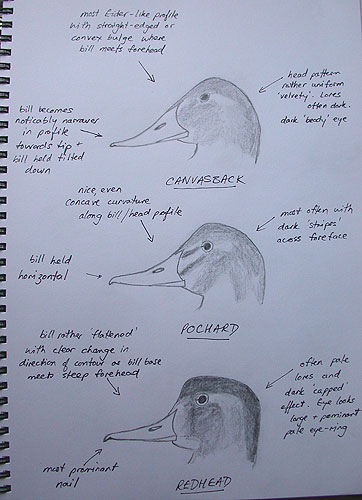 |
| Canvasback, Pochard and Redhead: (drawing: Martin Garner). |
The male Common Pochard is a stunning bird in full breeding plumage, but his partner is considerably less inspiring. It is not surprising that the 'brown' plumages of Pochard are not generally the focus of intense study by Britain's birdwatchers! However, such disinterestedness in female and juvenile Pochard may well result in overlooking the two rare sibling species: Redhead and Canvasback. While Common Pochard is roughly intermediate in appearance between the other two, its particular similarity to Canvasback in some plumages lead Palmer (1975: Handbook of North American Birds Vol.3) to say: 'Identifying young birds; also adults in late summer, may be very difficult, if in fact possible'.
Thus, European birdwatchers have the challenge of separating brown examples of these three species, and despite some very helpful identification resources on the subject in recent years, they can still cause real problems. This can be amply illustrated by the claims of Canvasback in England and Ireland in autumn 2004 that have proved to be Common Pochard, and the first real female Redhead in Scotland, which was, on first views, described as "a bird that looked to all intents and purposes like a female [Common] Pochard" (Scott, Gillon and Rivers 2004 Birding Scotland Vol.7 No. 3).
For birdwatchers keen to keep a hunters eye open for the rarer pair, the great news is they really could occur almost anywhere. As the BirdGuides information in the Online Guide to Rarer British Birds shows, Redhead has been recorded in Leicestershire and Nottinghamshire, and Canvasback in Greater Manchester. In fact any aquatic habitat (preferably eutrophic) favoured by other Aythyas has the potential to host these rarer beasts.
Training yourself
It is no surprise that 'brown' Common Pochards tend to get no more than a cursory glance much of the time. However, have you heard the tale about the training for those checking for counterfeits in the American Treasury? Instead of being trained in the various forms of counterfeit notes, it is reported that they only receive one type of training: they are trained in continuous and absolute familiarity with the real dollar bill. Counterfeit checkers know the weight, texture and patterns of real dollar bills so well that it is easy to spot even the best forgery. Even if the story is slightly extreme, it makes for a great philosophy. Re-applied to the identification challenge of these three pochards in brown plumages, the best way to find the rarer birds is to get to know the common birds inside out.
So, it becomes important to learn the subtle variations in plumage and bare parts to be found in Common Pochard, such as the regular presence of an all-black bill in summer females and fresh juveniles. It is also important to be familiar with the effects of diving and feeding behaviour on such things as the head shape and bill/head profile. Lack of real familiarity with some of these things has lead to some Pochards understandably being misidentified as Canvasbacks.
The work of learning the Common Pochard will reap real benefits for picking interesting hybrids (which I find in most larger flocks of Aythyas) and will put diligent students ahead of the pack when it comes to finding and correctly identifying a real rare duck such as a female or juvenile Redhead or Canvasback in the UK.
Now I will outline a paragraph of the overall impression of each species in brown plumages, followed by a concise checklist of what to look for, to help arrive at a clear identification. I have included some illustrations, which are not the greatest but hopefully serve to show you what I mean!
Canvasback
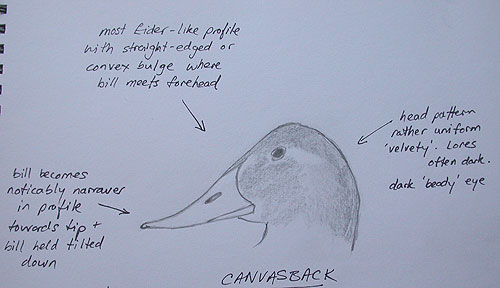 |
| Canvasback: (drawing: Martin Garner). |
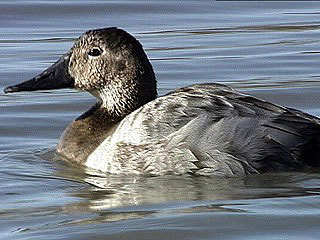 |
| Canvasback: USA Adult female (photo: BirdGuides). |
Canvasback is the largest of the three, with the longest bill, and a long 'ropy' or muscular looking neck, particularly when the bird is alert. It has the most triangular-shaped head with the peak of the crown the furthest back, often looking as though it is above and behind the eye. The long black bill is held at an angle tipped down from the horizontal and is noticeably thin in profile towards the tip and deep at the base. Where the bill and forehead meet, in profile, the contour is either straight or with slight convex bulge. The bill base where it meets the feathering often has a slightly raised, detached look, rather like an ill-fitting tooth crown next to the gum!
The loral area bulges out against the bill base in a convex curve more prominently than the other two species. The head plumage is generally rather uniform-looking with a velvety appearance and, while it can show a bit more patterning in the foreface, it is most often uniformly dark pigmented as opposed to pale (Redhead) or striped (Pochard). The eye has a tendency to look a little smaller and beadier than in Pochard.
Checklist for Canvasback
- Long black bill, slightly down-tilted, thin profile at tip, and deep based.
- Forehead/bill profile is straight edged or with convex bulge at forehead/bill base interface.
- Prominent loral bulge.
- Head shape is the most triangular, with crown peak often behind eye.
- Head plumage rather uniform, with often rather plain dark foreface.
Common Pochard
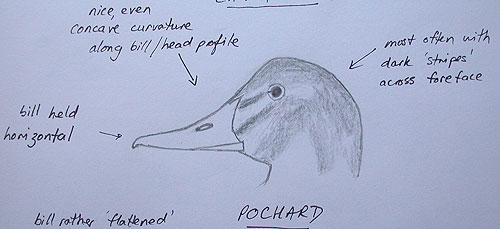 |
| Common Pochard: (drawing: Martin Garner). |
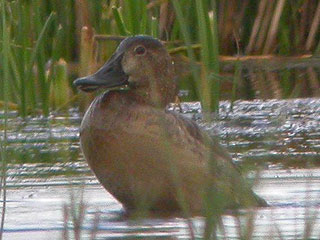 |
| Common Pochard: Co. Kerry, August 2004 Adult female fresh from diving. Notice how head appears sleeked-back and bill looks particularly large, inviting confusion with Canvasback (photo: Michael O'Keefe). |
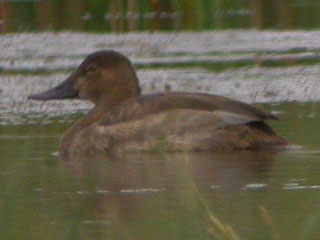 |
| Common Pochard: Co. Kerry, August 2004 Same bird...looking more much more like normal Pochard adult female (photo: Michael O'Keefe). |
Pochard is subtly the smallest of the three in size and closest in appearance to Canvasback. It is common for juvenile Pochards and summer female to have all-black bills, so it is important to use other criteria for identification. The most important feature is the bill profile that, with the forehead, forms a neat and continuous concave curve when relaxed. The loral region is commonly striped dark with a paler area in the middle of the lores, whereas in Redhead this area is usually all plain and pale, and in Canvasback it is usually plain and dark. There are exceptions, but the loral region is often a great indicator as to whether a particular bird is worth closer scrutiny. The crown shape of Pochard is on average peaked more forward than Canvasback, just above the eye, and the whole feel of head/bill and eye is well proportioned. The bill tends to be held horizontally compared to Canvasback.
Checklist for Common Pochard
- Bill can be all-black, usually held horizontally.
- Forehead/bill profile is of an even and gentle concave curvature along its length.
- Medium loral bulge.
- Well proportioned head with crown peak (when evident) approximately above the eye.
- Dark stripes straddling paler loral area is a common pattern.
Redhead
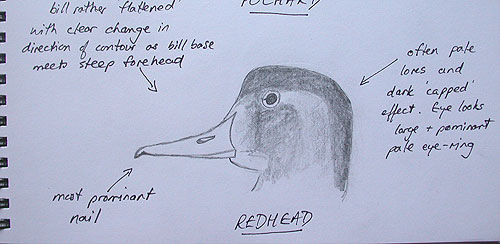 |
| Redhead: (drawing: Martin Garner). |
 |
 |
| Redhead: Barra, Outer Hebrides, February 2004 (photo: Martin Scott). | Redhead: Barra, Outer Hebrides, February 2004 (photo: Martin Scott). |
Redhead is intermediate in size between Pochard and Canvasback and sits slightly higher on the water than Pochard. It is more distinctive from the other two than they are from each other. Structurally the bill is rather flattish with the most prominently 'hooked' large nail of all three species.
The bill of Redhead can be all blackish in summer females and early juveniles. The most obvious feature in profile is the steep forehead above the bill base, rising to a crown peak in front of the eye and therefore more forward than the other two species. The whole head shape tends to be squarer, with a flattened, or slightly domed, effect on the crown.
In terms of female and juvenile plumage, Redhead tends to have the darkest patterning of all three species with dark cap and nape and often rather uniform pale foreface. The eye tends to look large and prominent with an obvious pale eye-ring. It's always worth checking the 'back end' as some can have obvious white undertail coverts (like on some Tufted Duck and Ferruginous Duck).
Checklist for Redhead
- More 'flattened' bill than Common Pochard rising slightly at bill base, held horizontally. Bill can be all black in summer females and early juveniles, though the black 'dipped' tip with thin paler subterminal band is a major feature of identification when present.
- Forehead/bill profile with distinct change of angle where steep forehead rises from bill base.
- Only slight loral bulge.
- Head shape the most square with peak of crown in front of eye, and square-topped or slightly domed crown. Often distinct dark cap and nape
- Pale, often plain, foreface and prominent pale eye-ring.
- Check for whitish undertail coverts.
Stop Press: Bruce Mactavish has commented that there have been no fewer than 10 Redheads in St John's, Newfoundland at the start of the week. There have been just 3 previous records of Redhead in Newfoundland, so the next British and Irish record might not be far away - Eds.




